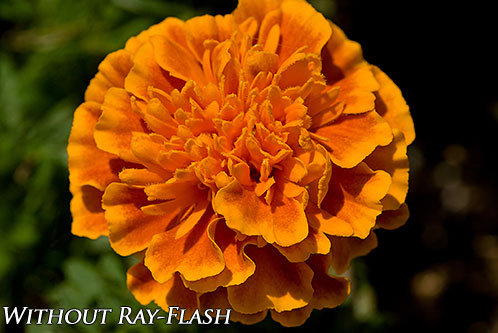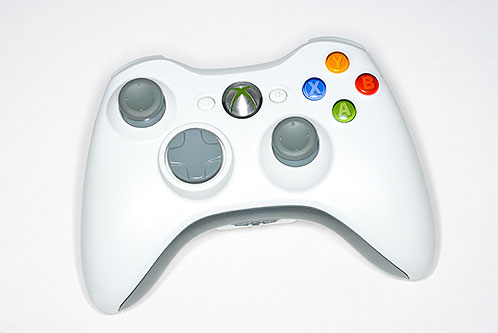The Ray Flash is an adapter that slides over the front of your flash and locks down to the top of the flash via a tightening knob. Your flash then shoots into a prism connected to a series of clear tube-looking rings that circle around the lens (the manufacturer calls these “light shapers”).

Installing the Ray Flash
Image Courtesy of ExpoImaging.
The light shapers are backed with a highly reflective surface to minimize light loss. The test readings we took indicated a light loss of a little over a stop, which is right around the norm for a lot of hot-shoe flash modifiers.
The opening on the front is pretty large, and we had no problem fitting a lens with a 77mm diameter through the Ray Flash opening. One design problem I encountered was the flash autofocus illuminator is blocked. Keep in mind, this can be very problematic if you plan on working with the Ray Flash in low-light conditions.
Perhaps the biggest advantage to the Ray Flash is the fact that it works full TTL with your flash. The flash did all of its normal TTL calculations and was still able to work as a Nikon CLS commander. This will probably be a huge selling point for most people and makes the Ray Flash very versatile.
Working with People/Animals
The Ray flash does its job of providing a shadowless look on the subject. If you are close to a wall or backdrop, it provides a very interesting shadow wrap that gives the subject an almost three-dimensional look, just like you’d expect out of a ring flash. I think perhaps my favorite part of the Ray Flash is the very interesting catch light it provides in your subject’s eye. The closer you get, the larger the ring looks.

The Ray Flash provides almost shadowless lighting with a very interesting catch light.
For shooting outdoors, it worked excellent as a fill-light. Since the light surrounds the lens, the light wraps around the subject and produces a very nice illumination.

Using the Ray Flash outdoors as a fill flash.
Macro/Close-Up Work
I think one of the other reasons people will plan to purchase the Ray Flash is for macro or close-up photography. Once again the Ray Flash did work in this application and did an excellent job of filling in some of the shadows. Below is a with/without example of the Ray Flash on a macro shot.

Nikon D200, 60mm f/2.8D Micro Nikkor, SB-800, f/13 @ 1/250 sec, ISO 100
Roll over for the before/after. Notice how the Ray Flash provides a subtle fill on the shadows but does not completely eliminate them. This makes the shot look much more natural.
I also did a little experiment with some tabletop photography, and it actually worked very well. This may not necessarily work for everything, but it does provide a very three-dimensional look when your subject is directly on a solid background.

The Ray Flash produces a three-dimensional looking shadow wrap when photographing objects close to a background.
Conclusion
The Ray Flash is a very viable solution for people who want a portable ring flash solution to take in the field. It works exactly as advertised and should provide a lot of versatility for wedding, portrait, or macro photographers.
Macro photographers may want to weigh their options since the Ray Flash is priced relatively close to dedicated macro flash systems. For people who work primarily in a studio environment, a dedicated ring flash might be a better alternative (the very popular Alien Bees ABR800 ring flash starts at about $100 more than the Ray Flash and provides quite a bit more power and modification options).
The Ray Flash is compatible with most Canon and Nikon bodies in conjunction with the 580EX/580EX II or the Nikon SB-800 (and presumably the SB-900 down the road) for $299.99.
There are different models for each camera/flash combination, and you can see a compatibility chart here.
Pros
- Works as advertised. The Ray Flash provides a lightweight, portable solution for photographers who want the look of a ring flash without the bulk of a studio ring flash. It definitely provides the light-wrapped look of a ring flash.
- TTL is no problem. All of your flash’s normal TTL operation works without a hitch. This makes the Ray Flash extremely easy to adapt to.
Cons
- Price. The price of $299.99 is very steep for a hot-shoe flash modifier. Even though it does work, the price is approaching your basic studio ring flashes or macro flash solutions.
- Construction. The lightweight construction is nice for portability but seems a little flimsy during regular use. There does seem to be a lot of play even with the provided wedge to prevent it.
.png)